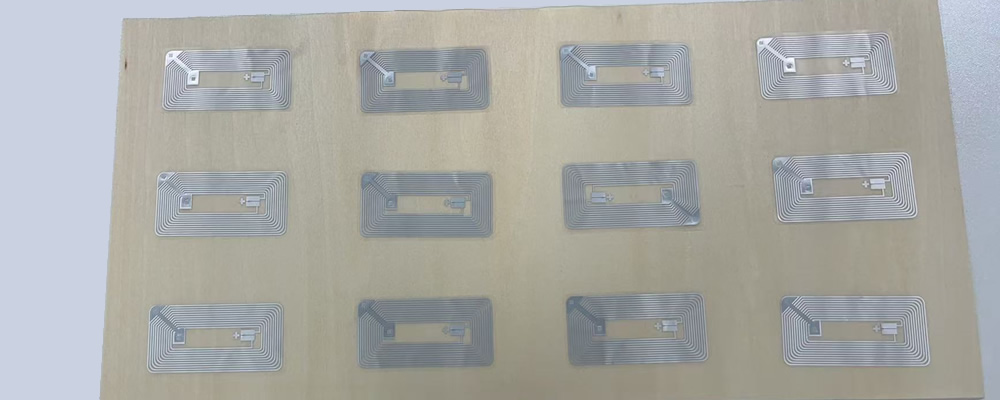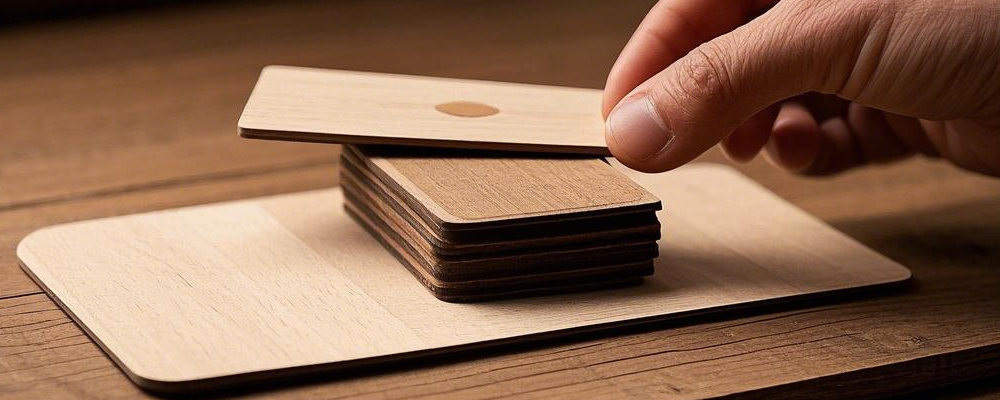RFID electronic tag embedded in the middle of a wooden card, which is the RFID chip and antenna component integrated into the wooden card. Below is a detailed introduction to this component:
RFID Electronic Tag in the Middle of a Wooden Card
The RFID electronic tag in the middle of a wooden card is the RFID chip and antenna embedded within the wooden card, enabling wireless communication and data transmission. It is the core technological component of a wooden RFID card, allowing the card to combine natural aesthetic appeal with smart functionalities, such as access control, payment systems, or membership management.
Components of the RFID Electronic Tag
- RFID Chip:
- This is the core of the electronic tag, responsible for storing and processing data.
- The chip’s storage capacity is usually small (ranging from a few bytes to several kilobytes), but sufficient to store unique identifiers or other necessary information.
- Common chip types include low-frequency (LF), high-frequency (HF), and ultra-high-frequency (UHF), depending on application requirements.
- Antenna:
- The antenna is used to receive and transmit radio signals, enabling communication with RFID readers.
- The antenna is typically designed as a coil and embedded within the layers of the wooden card.
- The size and shape of the antenna affect the reading range and performance of the RFID tag.
- Substrate:
- The RFID chip and antenna are usually mounted on a flexible substrate, such as PET (polyethylene terephthalate) or paper-based material.
- The substrate supports the chip and antenna, ensuring their stability and durability within the wooden card.
How the RFID Electronic Tag Works
- Energy Transmission:
- When an RFID reader emits a radio signal, the antenna in the wooden card receives the signal and converts it into electrical energy to power the chip.
- Data Transmission:
- The chip uses the received energy to activate and sends the stored data back to the reader via the antenna.
- Data transmission is wireless and contactless, typically occurring within a range of a few centimeters to several meters.
- Frequency Ranges:
- Low Frequency (LF, 125 kHz): Suitable for short-range reading, such as animal identification or access control cards.
- High Frequency (HF, 13.56 MHz): The most common frequency, used for payment cards, access cards, and membership cards.
- Ultra-High Frequency (UHF, 860-960 MHz): Suitable for long-range reading, such as logistics tracking or inventory management.
Integration of the RFID Electronic Tag into Wooden Cards
- Layered Design:
- The RFID electronic tag is typically sandwiched between two layers of wood veneer, ensuring it is completely hidden within the card.
- This design protects the electronic tag while maintaining the card’s aesthetic integrity.
- Protective Measures:
- To prevent damage to the electronic tag, wooden cards are often treated to be waterproof, moisture-resistant, and anti-static.
- A protective film or coating may be added around the electronic tag to enhance durability.
- Thickness Control:
- The overall thickness of the wooden card is usually controlled between 0.8 mm and 1.2 mm to ensure that embedding the electronic tag does not affect the card’s feel or usability.
Advantages of the RFID Electronic Tag
- Contactless Operation:
- Enables data reading without physical contact, offering convenience and hygiene.
- Durability:
- The electronic tag is embedded within the wooden card, protecting it from damage.
- Fast Reading:
- High-speed data transmission makes it suitable for scenarios requiring efficient processing.
- Versatility:
- Supports various applications, such as access control, payment systems, and membership management.
- Compatibility:
- Compatible with existing RFID readers and systems, making integration easy.
Applications
- Access Control:
- Used for access cards in offices, hotels, or residential buildings, providing a secure and aesthetically pleasing solution.
- Payment Systems:
- Integrated into wooden payment cards to enable contactless payment functionality.
- Membership Management:
- Used for gyms, clubs, or loyalty programs, offering a unique membership experience.
- Event Management:
- Used for passes at conferences, exhibitions, or events, enabling quick identity verification.
- Gift Cards:
- Enhances the functionality of wooden gift cards, supporting balance inquiries or transaction records.
The RFID electronic tag embedded in the middle of a wooden card is the core technological component of wooden RFID cards. By integrating the RFID chip and antenna into the wooden card, it combines natural aesthetic appeal with smart functionalities. Through contactless communication, the RFID electronic tag supports various applications, such as access control, payment systems, and membership management. Its durability, fast reading, and versatility make it an ideal choice for modern smart cards.



